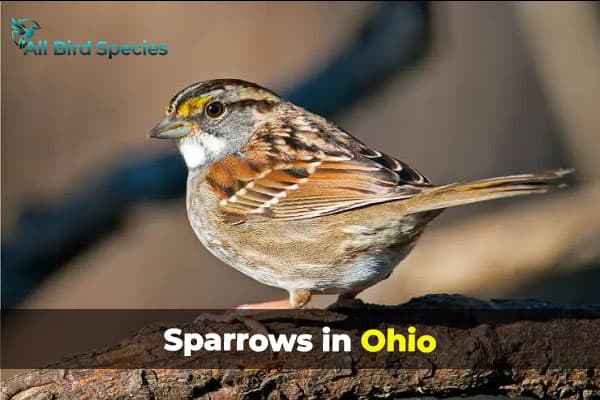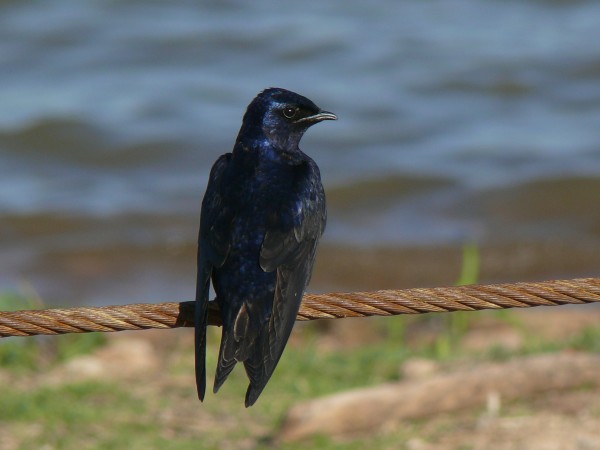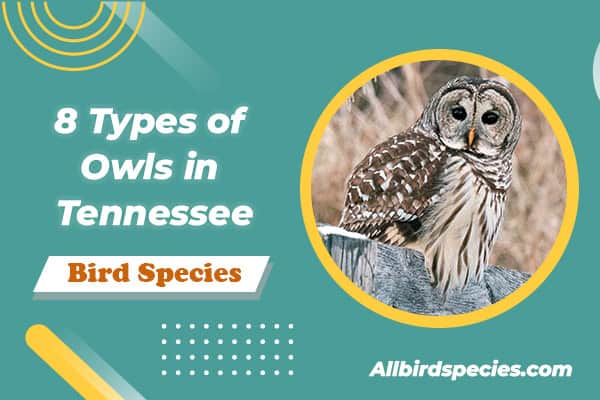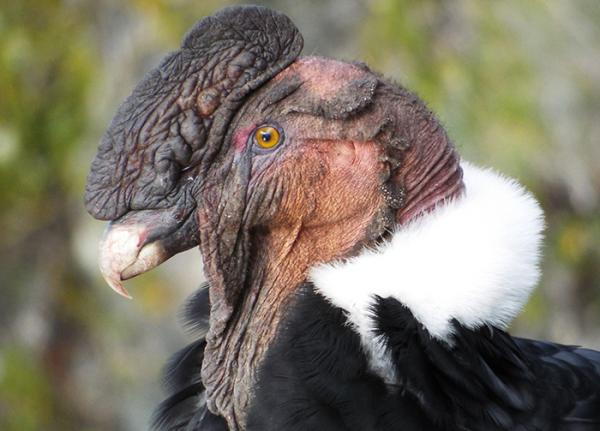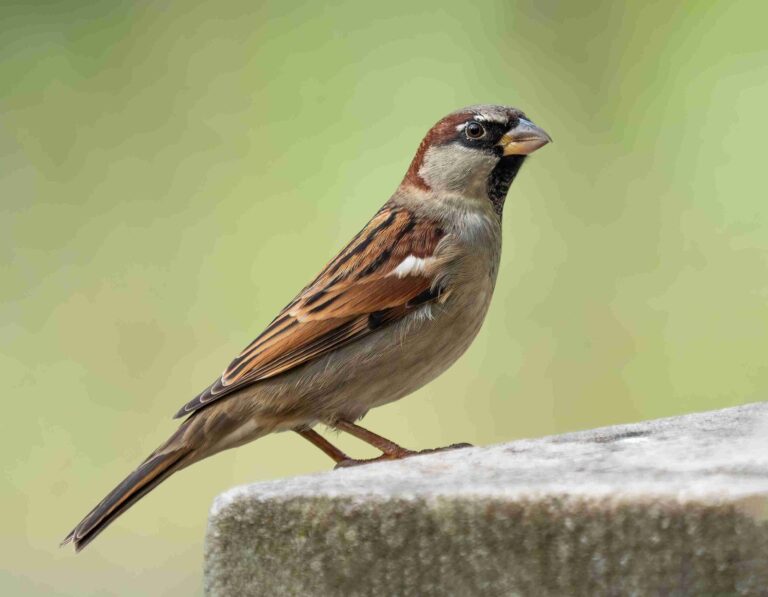12 Types Of Sparrows in Ohio (ID With Pictures)
Ohio is home to a wide variety of sparrows, each with its own unique characteristics and behaviors. These small, often overlooked birds play an important role in the ecosystem, from controlling insect populations to dispersing seeds. Although sparrows might not have the colorful feathers of cardinals or the graceful flight of hawks, their songs and behaviors make them fascinating to observe.
This article explores 12 sparrow species commonly found in Ohio, providing detailed information about each bird’s appearance, diet, and lifestyle. Whether you’re a seasoned birder or someone just curious about nature, learning about Ohio’s sparrows will give you a newfound appreciation for these small but mighty birds.
1. Song Sparrow (Melospiza melodia)
- Scientific name: Melospiza melodia
- Size: 5.5-7.1 inches (14-18 cm) in length
- Weight: 0.6-1.9 oz (18-53 g)
- Lifespan: 3-11 years
- Diet: Insects, seeds, and berries
The Song Sparrow is one of the most common and widespread sparrow species in Ohio. It can be found in almost any habitat, from backyards to wetlands, singing its distinctive and melodious tune. The males are known for singing, which they use to attract mates and defend their territories. Their adaptability and the ability to thrive in many different environments make them a well-known sight across the state.

Song Sparrows are easily recognized by their streaked brown and white feathers, and a central dark spot on their chest. They are one of the few sparrow species that stay in Ohio year-round, braving the cold winters by foraging for seeds. In the spring and summer, their diet shifts to insects, which they catch on the ground or snatch from vegetation. Their diverse diet allows them to survive in various environments, making them a frequent sight in both urban and rural areas.
Must Read: Hawks In Georgia
2. House Sparrow (Passer domesticus)
- Scientific name: Passer domesticus
- Size: 5.9-6.7 inches (15-17 cm) in length
- Weight: 0.9-1.4 oz (27-40 g)
- Lifespan: 3-5 years
- Diet: Grains, seeds, and scraps of human food
House Sparrows are not native to Ohio but were introduced from Europe in the 19th century. Despite their non-native status, they have adapted incredibly well to life alongside humans and are now one of the most common birds in urban areas across the state. You’ll often find House Sparrows around buildings, parks, and anywhere people live.

House Sparrows are small, chunky birds with brown and grey feathers. Males have black bibs on their chests, while females are more uniformly brown. Unlike many sparrows, House Sparrows are often found in urban settings where they rely on human activity for food. Their ability to thrive in man-made environments has led to their success across Ohio.
Sparrow in other Regions:
3. Chipping Sparrow (Spizella passerina)
- Scientific name: Spizella passerina
- Size: 4.7-5.9 inches (12-15 cm) in length
- Weight: 0.4-0.6 oz (11-16 g)
- Lifespan: 4-6 years
- Diet: Insects and seeds
The Chipping Sparrow is a small, slim sparrow with a bright rufous crown, especially during the breeding season. They are commonly found in open woodlands, parks, and gardens, making them a familiar sight during the warmer months in Ohio.
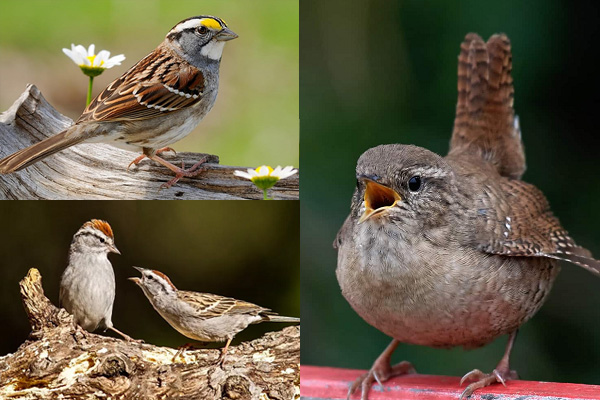
These sparrows are known for their neat appearance, with a greyish body, black eye stripe, and a reddish-brown cap. Chipping Sparrows are migratory, spending their winters in the southern U.S. and Central America. In Ohio, they are summer residents, returning each spring to breed. Their long trill song is a familiar sound in Ohio’s fields and forests.
4. Field Sparrow (Spizella pusilla)
- Scientific name: Spizella pusilla
- Size: 4.7-5.9 inches (12-15 cm) in length
- Weight: 0.4-0.6 oz (11-16 g)
- Lifespan: 5-9 years
- Diet: Seeds and insects
Field Sparrows are small, sweet-sounding birds that prefer open fields and prairies. They are less common in urban settings but can be found in rural areas throughout Ohio. Their gentle songs are a hallmark of springtime in grassland habitats.

Field Sparrows have a simple, clean appearance with a pinkish bill, a pale face, and rusty brown markings. They are more commonly heard than seen, as they tend to remain hidden in tall grass. However, their rising and falling song, resembling a bouncing ball, is easily recognizable.
5. Savannah Sparrow (Passerculus sandwichensis)
- Scientific name: Passerculus sandwichensis
- Size: 4.3-5.9 inches (11-15 cm) in length
- Weight: 0.5-1.0 oz (15-29 g)
- Lifespan: 3-5 years
- Diet: Seeds and insects
The Savannah Sparrow is a small, streaky bird often found in open grasslands, including farms and fields across Ohio. Named after the Savannah River, these sparrows are widespread and adaptable.
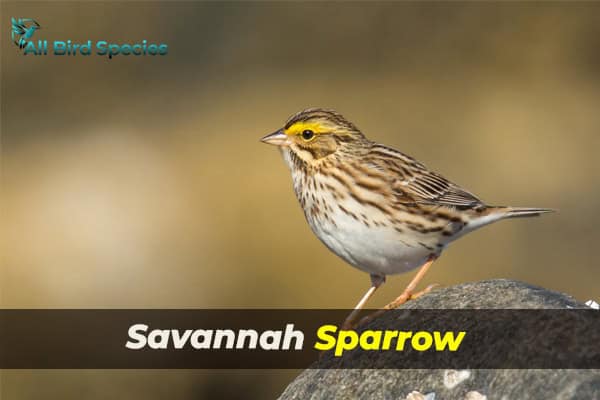
Savannah Sparrows are distinguished by their yellowish eyebrow (also called a “supercilium”) and their streaked bodies. These sparrows are migratory, arriving in Ohio in the spring to breed. During the breeding season, males can be seen singing from exposed perches in fields and meadows.
6. Grasshopper Sparrow (Ammodramus savannarum)
- Scientific name: Ammodramus savannarum
- Size: 4.3-5.1 inches (11-13 cm) in length
- Weight: 0.5-0.8 oz (14-23 g)
- Lifespan: 3-5 years
- Diet: Insects and seeds
The Grasshopper Sparrow gets its name from its insect-like song, which sounds much like the buzzing of a grasshopper. These sparrows prefer dry, open grasslands and are less common than some of the other sparrow species in Ohio.
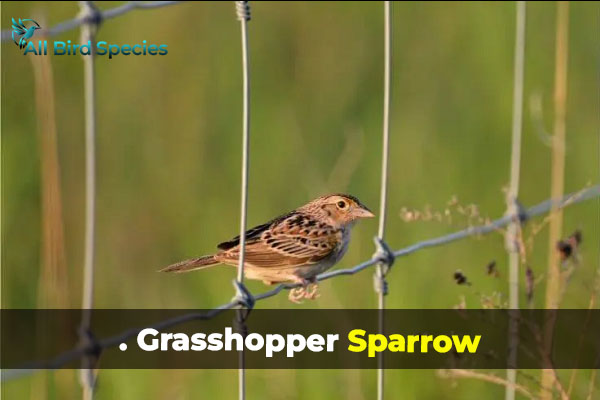
With a flat head and short tail, Grasshopper Sparrows are small and relatively plain in appearance, but their cryptic coloration helps them blend in with their grassland habitat. These birds are ground-nesters, hiding their nests among tall grasses to avoid predators.
7. Vesper Sparrow (Pooecetes gramineus)
- Scientific name: Pooecetes gramineus
- Size: 5.1-6.3 inches (13-16 cm) in length
- Weight: 0.7-1.0 oz (20-28 g)
- Lifespan: 3-6 years
- Diet: Seeds and insects
Vesper Sparrows are larger than many other sparrow species and are commonly found in farmlands, meadows, and open fields across Ohio. They are known for their evening (vesper) song, which is how they got their name.
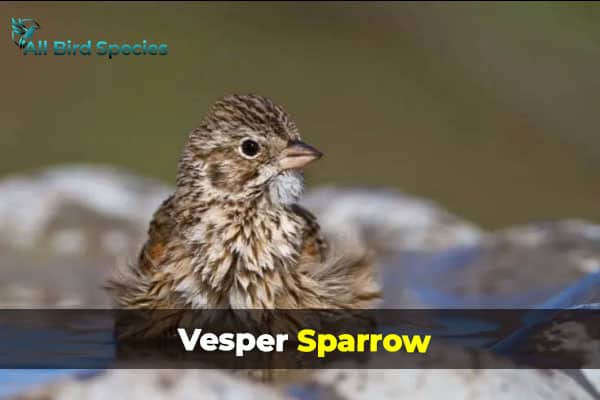
Vesper Sparrows are streaked brown and white, with a distinctive white outer tail feather visible in flight. These sparrows are ground-feeders and are often seen foraging for seeds in fields or along the edges of roads. Their song is melodious and sweet, often heard during the late afternoon or early evening.
8. Clay-colored Sparrow (Spizella pallida)
- Scientific name: Spizella pallida
- Size: 4.7-5.9 inches (12-15 cm) in length
- Weight: 0.5-0.6 oz (14-17 g)
- Lifespan: 2-3 years
- Diet: Seeds and insects
The Clay-colored Sparrow is a small, pale sparrow that prefers shrublands and open brushy areas. Though less common than other sparrows in Ohio, they can be spotted during migration and in the northern part of the state.

This sparrow is recognized by its pale, almost sandy-colored plumage and clear, unmarked breast. Their song, a soft buzzy trill, is often the first sign of their presence.
9. LeConte’s Sparrow (Ammospiza leconteii)
- Scientific name: Ammospiza leconteii
- Size: 4.3-5.1 inches (11-13 cm) in length
- Weight: 0.3-0.6 oz (10-17 g)
- Lifespan: 2-3 years
- Diet: Seeds and insects
LeConte’s Sparrow is a small, secretive bird that prefers marshy or wet meadows. These sparrows are not frequently seen due to their elusive nature, but they do pass through Ohio during migration.
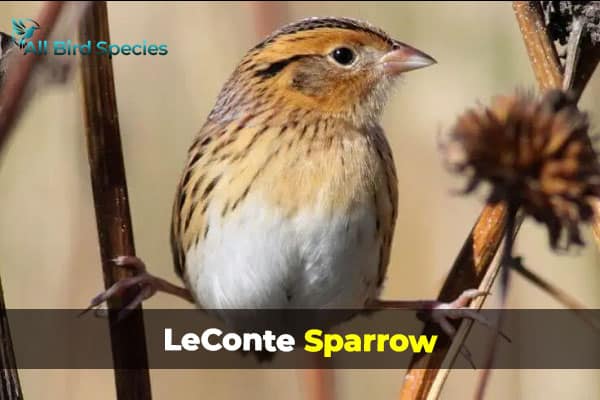
LeConte’s Sparrows are striking birds with orange faces and finely streaked backs. They prefer dense grasses, where they can remain hidden while foraging.
10. Fox Sparrow (Passerella iliaca)
- Scientific name: Passerella iliaca
- Size: 5.9-7.5 inches (15-19 cm) in length
- Weight: 0.9-1.2 oz (26-34 g)
- Lifespan: 3-5 years
- Diet: Seeds, berries, and insects
Fox Sparrows are large, chunky sparrows known for their reddish-brown plumage, which resembles the color of a red fox. They are primarily winter visitors in Ohio, often seen scratching in the leaf litter of wooded areas.

Fox Sparrows are ground-foragers, kicking up leaves and soil to uncover food. Despite their large size compared to other sparrows, they are shy and often remain in dense underbrush.
11. Nelson’s Sparrow (Ammospiza nelsoni)
- Scientific name: Ammospiza nelsoni
- Size: 4.3-5.1 inches (11-13 cm) in length
- Weight: 0.6-0.7 oz (17-20 g)
- Lifespan: 3-4 years
- Diet: Seeds and insects
Nelson’s Sparrows are secretive birds found in marshes and wetlands. Though not often seen in Ohio, they can be spotted during migration.
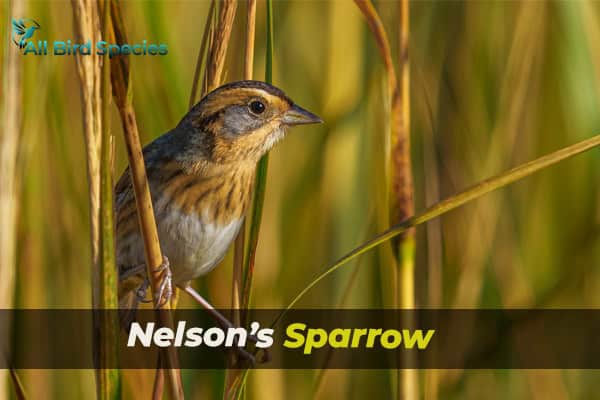
Nelson’s Sparrows have orange faces and finely streaked backs, much like LeConte’s Sparrows. They are more often heard than seen, with a sharp, insect-like call.
12. Swamp Sparrow (Melospiza georgiana)
- Scientific name: Melospiza georgiana
- Size: 4.7-5.9 inches (12-15 cm) in length
- Weight: 0.5-0.8 oz (15-24 g)
- Lifespan: 3-5 years
- Diet: Seeds and insects
As their name suggests, Swamp Sparrows are found in wetlands, swamps, and marshy areas. They are common in Ohio’s wetlands and are often spotted near water.

Swamp Sparrows are relatively plain birds with brownish bodies and a rusty cap. Their environment of choice, wetlands, makes them an important part of Ohio’s aquatic ecosystems.
Final Thoughts
In the end, there you have it: an exploration of the fascinating sparrows that call Ohio home! Whether you’re listening for the melodic tunes of the Song Sparrow or trying to spot the elusive LeConte’s Sparrow, Ohio’s sparrows offer a rich and rewarding birdwatching experience.
Read More🐦Related Articles:
- Small Birds with Long Beaks
- Hawks in Illinois
- Owls in Arkansas
- Hummingbirds in Florida
- Birds That Lay Blue Eggs
- Birds With Orange Heads
Frequently Asked Questions:
Q1. Are sparrows common in Ohio?
Yes, sparrows are quite common in Ohio, with various species frequently seen throughout the state.
Q2. Why is the lark sparrow endangered in Ohio?
The lark sparrow is endangered in Ohio primarily due to habitat loss from agricultural development and urbanization.
Q3. What is the most populated bird in Ohio?
The American Robin is one of the most populated birds in Ohio, often seen in backyards and parks.
Q4. Are House Sparrows invasive in Ohio?
Yes, House Sparrows are considered invasive in Ohio as they compete with native bird species for resources.

